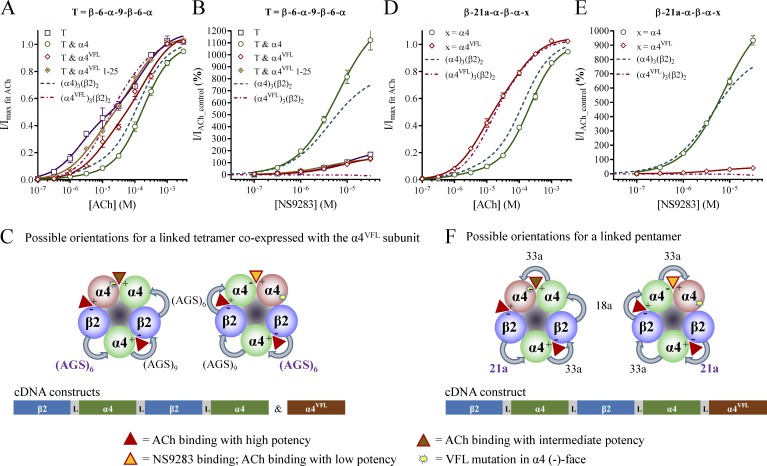Figure 3.
ACh and NS9283 sensitivity and potential stoichiometry of receptors from concatenated tetrameric or pentameric constructs. X. laevis oocytes were subjected to two-electrode voltage-clamp electrophysiology. Electrophysiological data were evaluated as described in Materials and methods; also see Fig. 1. (A and B) ACh (A) and NS9283 (B) CRRs were obtained from oocytes injected with the tetrameric β-6-α-9-β-6-α (T) construct alone or coinjected with monomeric α4 or α4VFL subunits in a 1:1 ratio. Data from n = 5–13 experiments are depicted as means ± SEM as a function of the ACh or NS9283 concentration, and regression results are presented in Table 2. Data for wild-type receptors from monomeric subunits in Fig. 1 are indicated as dashed lines. (C) Functional 3α:2β stoichiometry receptors arising from coinjections of β-6-α-9-β-6-α and α4VFL could originate from assembly of the concatenated construct in either a clockwise or a counterclockwise orientation when viewed from the synaptic cleft. With respect to NS9283 sensitivity, receptors with the tetramer in the clockwise orientation will resemble wild-type 3α:2β receptors, whereas receptors with the tetramer in the counterclockwise orientation will resemble wild-type 2α:3β receptors. (D and E) ACh (D) and NS9283 (E) CRRs were obtained from oocytes injected with the indicated pentameric constructs, in which x indicates either the α4 or the α4VFL subunit in the fifth construct position. Data from n = 12–19 experiments are depicted as means ± SEM as a function of the ACh or NS9283 concentration, and regression results are presented in Table 2. (F) When injecting the pentameric construct including the α4VFL subunit, clockwise and counterclockwise assemblies lead to different receptors, and NS9283 behaves differentially as described in C. Note that in the receptor illustrations, the first construct linkers are indicated with bold purple font, and specific linker sequences are shown in Table 3.

